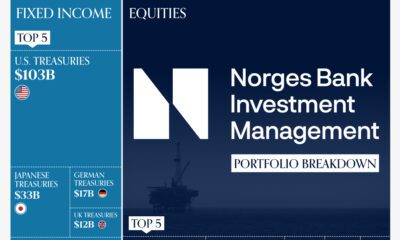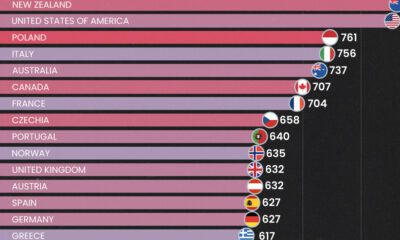Technology
The ‘Doomsday Vault’ is a Backup Plan to Save the World’s Most Vital Crops
Imagine that the unthinkable has happened.
A massive asteroid impact triggers a “nuclear winter” effect, or one of the world’s most dangerous supervolcanos erupts. Maybe Donald Trump gets in an epic Twitter feud with Kim Jong-Un that initiates World War 3.
Either way, things are going sideways, and the fate of human civilization itself is at stake. Will everything be lost?
Enter the ‘Doomsday Vault’
Well, besides the fact that the world’s cities have been replaced by smoking craters, there is some good news for the humans that survive a potentially apocalyptic scenario.
On a remote island that is just 800 miles (1,300 km) from the North Pole, the Norwegian government has built a failsafe in the freezing cold that protects thousands of the most vital crops from extinction. Officially called the Svalbard Global Seed Vault, it already holds close to a million samples of crops around the world, with each sample holding about 500 seeds.
Today’s infographic, from Futurism, has more on this Doomsday Vault that could one day help to save civilization:

Carved 390 ft (120 m) into a sandstone mountain in a Norwegian archipelago, the vault keeps the temperature of seeds well below freezing while also limiting humidity. This minimizes metabolic activity, which means that the seed vault will likely be able to preserve seeds for most major crops for thousands of years.
Already Handy Once
Despite remaining a pragmatic backup plan for the worst case global scenarios, the Doomsday Vault has already come in handy just a few years into its existence. In 2015, war-torn Syria was the first country to withdraw seeds from the vault in order to replace those lost in Aleppo due to the ongoing civil conflict.
The wheat, barley, and grass seeds from the Aleppo bank are thought to have important traits resistant to drought, which researchers think could be increasingly important in the face of climate change.
Technology
Visualizing AI Patents by Country
See which countries have been granted the most AI patents each year, from 2012 to 2022.

Visualizing AI Patents by Country
This was originally posted on our Voronoi app. Download the app for free on iOS or Android and discover incredible data-driven charts from a variety of trusted sources.
This infographic shows the number of AI-related patents granted each year from 2010 to 2022 (latest data available). These figures come from the Center for Security and Emerging Technology (CSET), accessed via Stanford University’s 2024 AI Index Report.
From this data, we can see that China first overtook the U.S. in 2013. Since then, the country has seen enormous growth in the number of AI patents granted each year.
| Year | China | EU and UK | U.S. | RoW | Global Total |
|---|---|---|---|---|---|
| 2010 | 307 | 137 | 984 | 571 | 1,999 |
| 2011 | 516 | 129 | 980 | 581 | 2,206 |
| 2012 | 926 | 112 | 950 | 660 | 2,648 |
| 2013 | 1,035 | 91 | 970 | 627 | 2,723 |
| 2014 | 1,278 | 97 | 1,078 | 667 | 3,120 |
| 2015 | 1,721 | 110 | 1,135 | 539 | 3,505 |
| 2016 | 1,621 | 128 | 1,298 | 714 | 3,761 |
| 2017 | 2,428 | 144 | 1,489 | 1,075 | 5,136 |
| 2018 | 4,741 | 155 | 1,674 | 1,574 | 8,144 |
| 2019 | 9,530 | 322 | 3,211 | 2,720 | 15,783 |
| 2020 | 13,071 | 406 | 5,441 | 4,455 | 23,373 |
| 2021 | 21,907 | 623 | 8,219 | 7,519 | 38,268 |
| 2022 | 35,315 | 1,173 | 12,077 | 13,699 | 62,264 |
In 2022, China was granted more patents than every other country combined.
While this suggests that the country is very active in researching the field of artificial intelligence, it doesn’t necessarily mean that China is the farthest in terms of capability.
Key Facts About AI Patents
According to CSET, AI patents relate to mathematical relationships and algorithms, which are considered abstract ideas under patent law. They can also have different meaning, depending on where they are filed.
In the U.S., AI patenting is concentrated amongst large companies including IBM, Microsoft, and Google. On the other hand, AI patenting in China is more distributed across government organizations, universities, and tech firms (e.g. Tencent).
In terms of focus area, China’s patents are typically related to computer vision, a field of AI that enables computers and systems to interpret visual data and inputs. Meanwhile America’s efforts are more evenly distributed across research fields.
Learn More About AI From Visual Capitalist
If you want to see more data visualizations on artificial intelligence, check out this graphic that shows which job departments will be impacted by AI the most.
-

 Markets1 week ago
Markets1 week agoU.S. Debt Interest Payments Reach $1 Trillion
-

 Markets2 weeks ago
Markets2 weeks agoRanked: The Most Valuable Housing Markets in America
-

 Money2 weeks ago
Money2 weeks agoWhich States Have the Highest Minimum Wage in America?
-

 AI2 weeks ago
AI2 weeks agoRanked: Semiconductor Companies by Industry Revenue Share
-

 Markets2 weeks ago
Markets2 weeks agoRanked: The World’s Top Flight Routes, by Revenue
-

 Countries2 weeks ago
Countries2 weeks agoPopulation Projections: The World’s 6 Largest Countries in 2075
-

 Markets2 weeks ago
Markets2 weeks agoThe Top 10 States by Real GDP Growth in 2023
-

 Money2 weeks ago
Money2 weeks agoThe Smallest Gender Wage Gaps in OECD Countries













